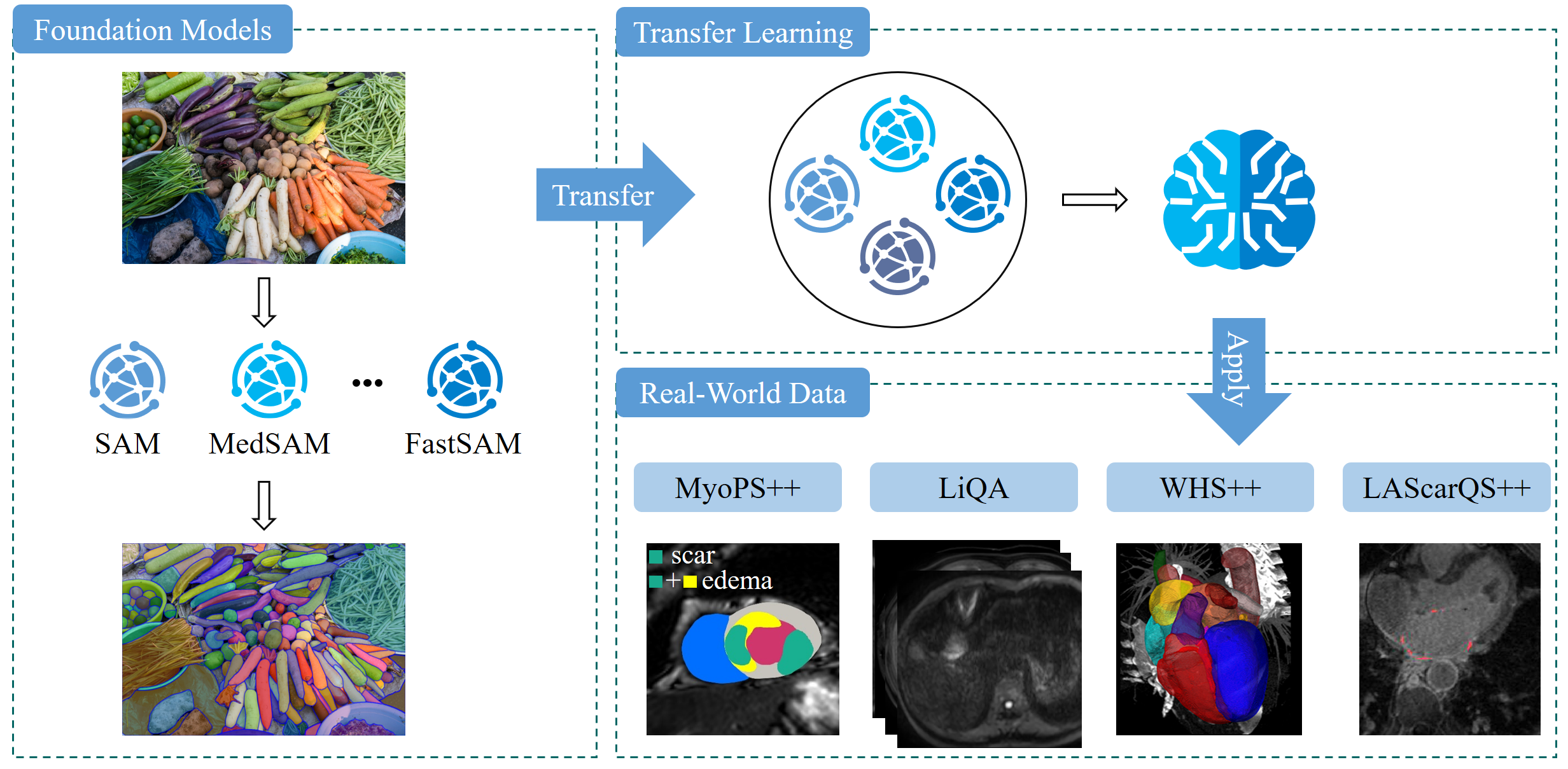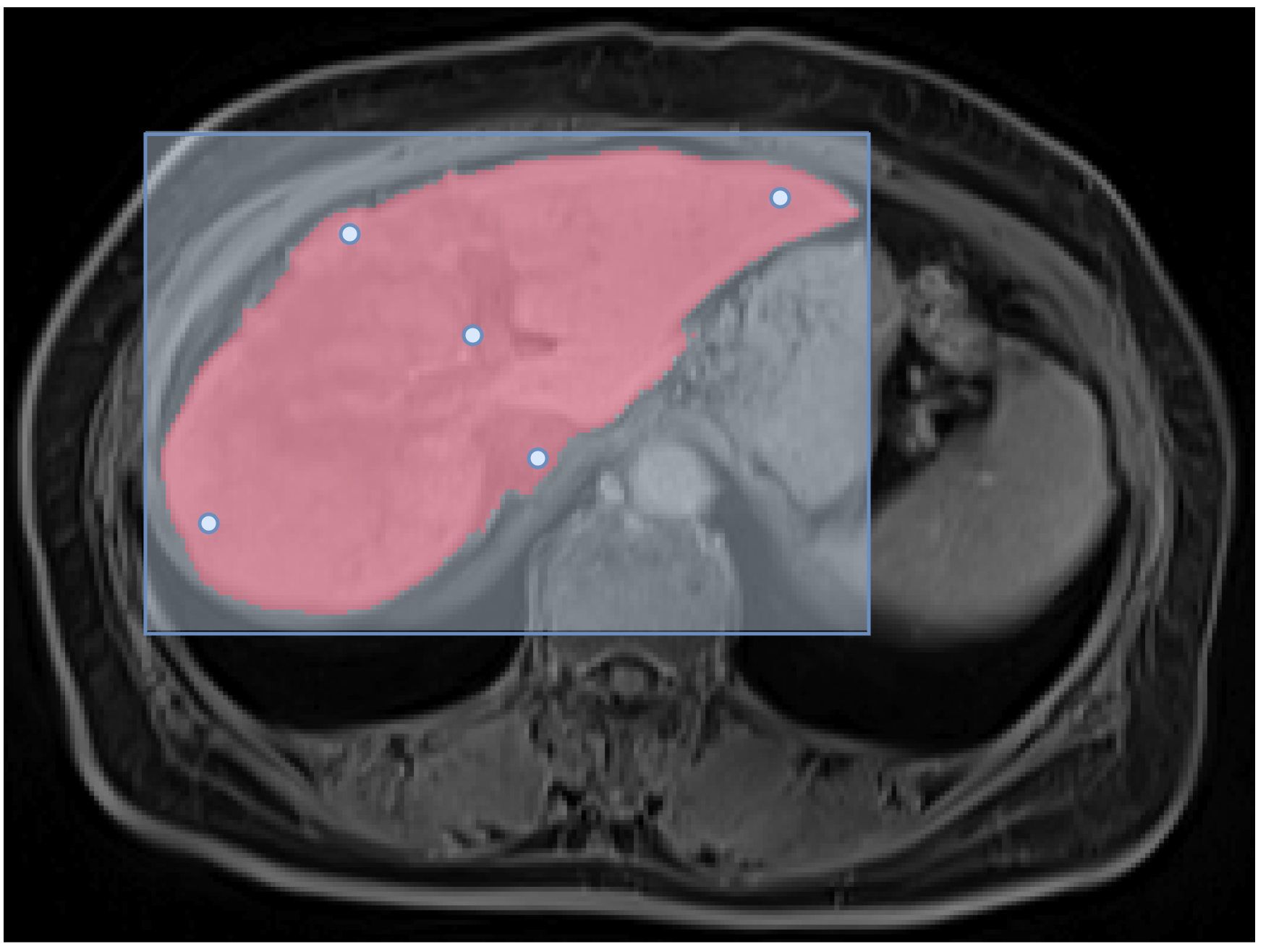TFM4MedIA
Transferring Foundation Models for Multi-center Real-World Medical Image Analysis
Motivation

While foundation models like the Segment Anything Model (SAM)
Task
In this track, we encourage participants to design effective transfer learning approaches to exploit the knowledge from existed foundation models efficiently and make them more effective in four segmentation tasks, including Myocardial Pathology Segmentation in MyoPS++ track, Liver Segmentation in LiQA track, Whole Heart Segmentation in WHS++ track and Left Atrial and Scar Segmentation in LAScarQS++ track.
Note: To address this task, participants are encouraged to leverage external data.
Data
Multi-center datasets are provided for four sub-tasks. More detailed data information can be found here for Myocardial Pathology Segmentation, Liver Segmentation, Whole Heart Segmentation and Left Atrial and Scar Segmentation.
Training Dataset
1). Myocardial Pathology Segmentation
| Center | Num. patients | Sequences | Manual labels |
|---|---|---|---|
| 1 | 81 | LGE | Scar, left ventricle and myocardium |
| 2 | 50 | LGE, T2 and bSSFP | Scar, edema, left ventricle, myocardium and right ventricle |
| 3 | 45 | LGE, T2 and bSSFP | Scar, edema, left ventricle, myocardium and right ventricle |
| 5 | 07 | LGE and bSSFP | Scar, left ventricle, myocardium and and right ventricle |
| 6 | 09 | LGE and bSSFP | Scar, left ventricle, myocardium and and right ventricle |
| 7 | 08 | LGE and bSSFP | Scar, left ventricle, myocardium and and right ventricle |
| Vendor | Center | Num. studies | Num. Annotations |
|---|---|---|---|
| A | A | 100 | 10 |
| B | B1 | 100 | 10 |
| B | B2 | 50 | 10 |
| Center | Num. patients | Modalities |
|---|---|---|
| A | 20 | CT |
| B | 20 | CT |
| C/D | 20 | MRI |
| E | 26 | MRI |
4). Left Atrial and Scar Segmentation
| Center | Modality | Num. task1 | Num. task2 |
|---|---|---|---|
| A | LGE MRI | 60 | 130 |
Validation Dataset
1). Myocardial Pathology Segmentation
| Center | Num. patients | Sequences | Manual labels |
|---|---|---|---|
| 4 | 25 | LGE, T2 and bSSFP | Scar, edema, left ventricle, myocardium and right ventricle |
| Vendor | Center | Num. studies | Num. Annotations |
|---|---|---|---|
| A | A | 10 | 10 |
| B | B1 | 10 | 10 |
| B | B2 | 10 | 10 |
| Center | Num. patients | Modalities |
|---|---|---|
| A | 20 | CT |
| B | 10 | CT |
| C/D | 20 | MRI |
4). Left Atrial and Scar Segmentation
| Center | Modality | Num. task1 | Num. task2 |
|---|---|---|---|
| A | LGE MRI | 10 | 10 |
| C | LGE MRI | 0 | 10 |
Test Dataset
1). Myocardial Pathology Segmentation
| Center | Num. patients | Sequences | Manual labels |
|---|---|---|---|
| 4 | 25 | LGE, T2 and bSSFP | Scar, edema, left ventricle, myocardium and right ventricle |
The 160 test cases corresponded to 120 new cases from the vendors provided in the training set and 40 additional cases from a third unseen center, that were tested for model generalizability.
| Vendor | Center | Num. studies |
|---|---|---|
| A | A | 40 |
| B | B1 | 40 |
| B | B2 | 40 |
| C (new) | C | 40 |
| Center | Num. patients | Modalities |
|---|---|---|
| A | 20 | CT |
| B | 14 | CT |
| C/D | 20 | MRI |
| F | 16 | MRI |
4). Left Atrial and Scar Segmentation
| Center | Modality | Num. task1 | Num. task2 |
|---|---|---|---|
| A | LGE MRI | 24 | 14 |
| B | LGE MRI | 0 | 20 |
| C | LGE MRI | 0 | 10 |
Prompts

- Only points or bounding boxes are acceptable as prompts. Participants can generate prompts based on the segmentation ground truth by themselves for the training dataset.
- For validation and testing testing, no more than 5 points and 1 bounding box are provided by organizers for each class as prompts. An example can be seen in the Figure 2.
Metrics & Ranking
Metrics
Dice Similarity Coefficient (DSC), Hausdorff Distance (HD).
Rank methods
The overall performance across all sub-tasks are considered for ranking: 1) Firstly, for each sub-task, the results will be ranked according to the Dice score on in-distribution (seen centre) and out-of-distribution (OOD, unseen centre) dataset, respectively. 2) Then the ranking results of all sub-tasks are averaged as the final rank.
This ranking approach encourage the participants to develop methods from foundation models to be consistently effective across all tasks as well as on OOD datasets.
Rules
- Publicly available data and pretrained model are allowed.
Registration
Please register here to participate in the challenge and get access to the dataset!
Submission Guidance
Model Submission
After registration, we will assign participants an account to login into our TFM4MedIA evaluation platform. Participants can directly upload your predictions on the validation data (in nifty format) via the website. Note that evaluation of validation data will be allowed up to 10 times for each task per team. For fair comparison, the test dataset will remain unseen. Participants need to submit their docker models for testing.
Paper Submission
Please refer to our paper submission guidance.
Docker Submission (New!!!)
Since the aim of TM4MedIA is one model for all tasks, we make the name/directory/paths of a specific test task anonymous to avoid anyone using the information to select a specfiic model (e.g., nnUnet) for each test task. Therefore, we copy all test images of a specific task into the directory “:/input/images/” and save the corresponding prompts to the path “:/input/prompts.json”. For convenience, the json structure keeps the same as the validation phase. For example, the structure of “:/input” is
:/input
|-- prompts.json
|-- images
|-- Case ID1.nii.gz
|-- Case ID2.nii.gz
...
|__ Case IDN.nii.gz
Note that for MyoPS++, one case has three sequences, i.e., “Case ID_C0.nii.gz”, “Case ID_LGE.nii.gz”, and “Case ID*_T2.nii.gz”.
The structure of “:/input/prompts.json” is
{
"Case ID1":
{
"Slice Id1": null, #set to null if no/tiny foreground
...
"Slice IDk":
{
"Label ID1":
[
[x, y, x + h, y + w], #bounding box prompt
[[x1, y1],[x2, y2], ...] #point prompt, the number of points ranges in [1,5]
]
...
}
...
}
...
}
Orientations: when apply prompts to images, the orientation of loading images should be set to axcodes="PLS".
Your docker should read the input test images from the directory “:/input/images”, load the input prompts from the path “:/input/prompts.json”, and output the corresponding predictions into the directory “:/output”. The recommended structure of the directory “:/output” is
:/output
|-- Case ID1_pred.nii.gz
|-- Case ID2_pred.nii.gz
...
|__ Case IDN_pred.nii.gz
The output segmentation should keep the same size as its original image/case. For the slices with null prompt, just label all areas as Label ID=0. For the slices with prompts, the label of segmentation should keep the same as the given label of prompts ("Label ID"). Note that inconsistent labels would lead to incorrect evaluation.
Timeline
The schedule for this track is as follows. All deadlines(DDLs) are on 23:59 in Pacific Standard Time.
| Training Data Release | May 10, 2024 |
|---|---|
| Validation Phase | |
| Test Phase | |
| Abstract Submission | |
| Paper Submission | |
| Notification | September 15, 2024 |
| Camera Ready | September 25, 2024 (DDL) |
| Workshop (Half-Day) | October 10, 2024 |
Citations
Please cite these papers when you use the data for publications:
@article{Wu2023SemiSL,
author={Wu, Fuping and Zhuang, Xiahai},
journal={IEEE Transactions on Pattern Analysis and Machine Intelligence},
title={Minimizing Estimated Risks on Unlabeled Data: A New Formulation for Semi-Supervised Medical Image Segmentation},
year={2023},
volume={45},
number={5},
pages={6021-6036},
}
@article{GAO2023BayeSeg,
title = {BayeSeg: Bayesian modeling for medical image segmentation with interpretable generalizability},
journal = {Medical Image Analysis},
volume = {89},
pages = {102889},
year = {2023},
author = {Shangqi Gao and Hangqi Zhou and Yibo Gao and Xiahai Zhuang},
}
Contact
If you have any problems about this track, please contact Dr. Fuping Wu or Dr. Shangqi Gao.